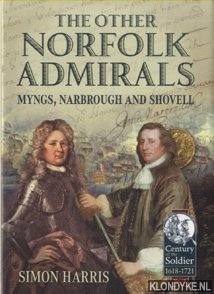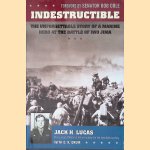
Onze boeken
The Other Norfolk Admirals Myngs, Narbrough and Shovell
Door Simon Harris
Categorie | Algemeen Militaria |
|---|---|
Boeknummer | #218809 |
Titel | The Other Norfolk Admirals Myngs, Narbrough and Shovell |
Auteur | Harris, Simon |
Boektype | Gebonden hardcover met stofomslag |
Uitgeverij | Helion & Company Limited |
Jaar van uitgave | 2017 |
ISBN10 | 1912174227 |
ISBN13 | 9781912174225 |
Taal | Engels |
Samenvatting | Winner of the Bronze Award at the Military History Matters Book of the Year Awards 2019 The careers of the three Norfolk admirals were intimately related. Narbrough and Shovell came from the small North Norfolk hamlet of Cockthorpe and Myngs from nearby Salthouse. In the 1660s, Myngs was the captain, Narbrough the lieutenant and Shovell the lowly cabin boy in the same ship. It is also possible that they were all related at least by marriage. In the majority of the naval wars of the second half of the seventeenth and the early eighteenth centuries one or other of them was invariably present. Cloudesley Shovell was born to a yeoman farmer; he entered the Navy whilst still a boy and, in 1676, came to national prominence by burning the four ships of the Dey of Tripoli right under his castle ... (Lees verder)walls. This led to conflict with Samuel Pepys over a gold medal that the generous Charles II had awarded Shovell. Later there was a spectacular falling out with James II over the new king's Catholicism. Following Narbrough's premature death, Shovell married his widow: effectively the cabin boy marrying the admiral's widow which is unique in British naval history. Brave to a fault, in the reigns of William and Mary, and Anne, Shovell became the leading fighting admiral of the age. In 1707, at the very height of his considerable powers, Shovell and nearly 2,000 men drowned after his ships were wrecked on the rocks of Scilly. According to his grandson, Shovell arrived on the shore alive and was then brutally murdered for the sake of an emerald ring on his finger. Faulty navigation was at the heart of Shovell's demise; did he keep his appointment with the celebrated scientist, Sir Isaac Newton, to discuss longitude? New theories concerning the causes of the disaster are examined and also the fate of his gold dinner service. Explorer, navigator, consummate sailor and naval administrator, John Narbrough was all this and more. No biography of Narbrough has been produced for 85 years and much new material has come to light in this time. For example the rediscovery of the ship, the Nuestra Senora de la Concepcion from which Narbrough was trying to salvage sunken Spanish silver when he died from a mysterious illness. In addition, the British Library recently raised a large sum of money to buy Narbrough's journals of his voyage [1669-71] into the Pacific Ocean and up to, what is now, modern day Chile. He illustrated his journals with paintings of the flora and fauna plus accurate depictions of the harbours that he visited. On his return journey, Narbrough became the first Englishman to sail through the Strait of Magellan from west to east. Both Narbrough and Shovell owed so much to Christopher Myngs and yet no comprehensive biography of him has yet been written. In the 1650s, out in the West Indies, he played very much the part of an Elizabethan buccaneer with repeated attacks on the Spanish Main. After helping himself to treasure that more properly belonged to the state, he was shipped home to England in semi-disgrace. However, in the run-up to the Restoration of the monarchy, the authorities did not think it appropriate to discipline the most popular man in the Navy. Later, at the Four Days' Battle of 1666, Myngs leading the English van, would attempt to fight on despite having his face shattered by a musket ball. Six days later, he died at his home in London and was buried in an East London churchyard which has now become a seedy park. He deserved better. |
Pagina's | 275 |
Conditie | Nieuw |
Prijs | € 15,00 |

Onze gebruikte boeken verkeren in goede tweedehands staat, tenzij hierboven anders beschreven. Kleine onvolkomenheden zijn niet altijd vermeld.










